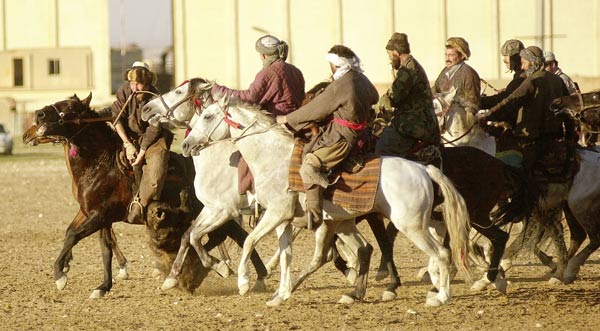Buzkashi is a traditional and thrilling horseback game that originated in Central Asia, particularly in Afghanistan, Kyrgyzstan, Tajikistan, and northern areas of Pakistan and India. The game, which translates to “goat grabbing” in Persian, involves skilled horsemen competing for possession of a carcass and attempting to score points by getting it to a designated area. Here’s an overview of Buzkashi:
Key Features:
- Objective:
- Carcass:
- Traditionally, a headless and limbless goat carcass is used in Buzkashi. However, in some variations of the game, a calf or sheep carcass may be used. The carcass can weigh several dozen kilograms.
- Field and Scoring:
- The playing field in Buzkashi can be quite large, and the goal lines or scoring circles are typically marked at a distance from each other. The game may take place in open fields, often on rough and challenging terrain.
- Teams and Players:
- Buzkashi is usually played between two teams, each consisting of skilled horsemen. The number of players on each team can vary. The game is highly physical, and riders need both equestrian and strategic skills.
Rules and Gameplay:
- Starting the Game:
- The game begins with a neutral player, called the “tossak,” throwing the carcass into the center of the field. The chapandazes then rush towards it, attempting to pick it up from the ground.
- Possession and Scoring:
- Once a chapandaz has possession of the carcass, they attempt to carry it to the goal line or the scoring circle. Opponents try to intercept and wrestle the carcass away. Points are scored when the carcass crosses the goal line or enters the scoring circle.
- Challenges and Obstacles:
- Buzkashi is a physically demanding and intense game. Chapandazes face numerous challenges, including other riders attempting to grab the carcass, crowded conditions around the goal, and navigating through challenging terrains such as mud, snow, or rocky landscapes.
- Dismounting Opponents:
- Chapandazes are allowed to dismount opponents to gain possession of the carcass. This can involve pulling riders off their horses or engaging in physical confrontations to secure the prize.
- Game Duration:
- The duration of a Buzkashi match can vary. The game continues until a predetermined number of points are scored, or a specified time limit is reached.
Cultural Significance:
- Historical Tradition:
- Buzkashi has deep historical roots in Central Asian cultures and has been played for centuries. It is often associated with warrior traditions and reflects the equestrian skills valued in these societies.
- Celebratory Events:
- Buzkashi events are not only sporting competitions but also cultural celebrations. They are occasions for communities to come together, showcasing horsemanship, strength, and camaraderie.
- Symbol of Strength:
- Buzkashi is seen as a symbol of strength, courage, and skill. Chapandazes are admired for their equestrian abilities, and the game is a testament to the bond between horse and rider.
- National Sport:
- In some Central Asian countries, Buzkashi is considered a national sport and is played at special events and festivals. It holds cultural significance and is often accompanied by traditional music and festivities.
Buzkashi is a unique and captivating equestrian sport that not only showcases the physical prowess of riders but also reflects the cultural heritage of the Central Asian regions where it has been practiced for generations.











